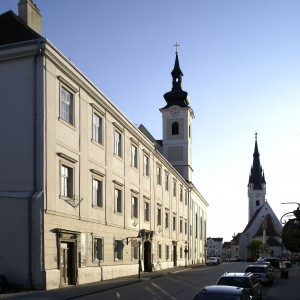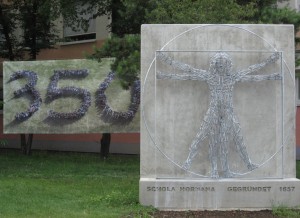
Josef Kolbe attended the grammar school at Horn, Lower Austria, from 1884 to 1888. The “Schola Hornana” or the “Horner Gymnasium” was founded in 1657 and is one of the oldest schools in Austria. Its teaching staff were Piarists, fathers of the oldest Catholic educational order, whose main occupation was the schooling of children and youth. The school was endowed by Count Ferdinand Sigismund von Kurz and his wife Regina for not entirely altruistic reasons. At the beginning of the 17th century Horn was still protestant, but reverted to catholicism during the counter reformation. The Count wished to consolidate catholicism in the hearts and minds of the population through the influence of a monastic church and school.
The school opened on 9 April 1657 in a cloth maker’s house in the Wiener Strasse, the main street of Horn, with ten Piarist fathers as teachers under the rectorship of Michael Geiselbrunner. Work started on the adjacent baroque church of St. Anthony during the following year and was completed in 1662. By the end of the first school year the initial intake of twenty pupils had risen to 112, mostly drawn from the nobility, bourgeoisie and the landed gentry of Horn and its surroundings, but also later from further afield (Vienna, Bavaria, Swabia and the countries of the Austro-Hungarian Empire), as the school’s reputation grew. The original four subjects – reading, writing, arithmetic and basic Latin – were extended to resemble those that are still taught in the classrooms of today. The former cloth maker’s house gradually took on the appearance of a school: a new wing was added in 1733 and a further four classrooms were constructed in 1820. In 1872 administration passed from the Piarists to the authorities of Lower Austria, in 1873 a garden was added and in 1874 senior classes were introduced.


Josef Kolbe did not attend the senior classes, but he probably boarded in the house specially built for the pupils next to the school which opened its doors in 1884, as his father was still the head teacher of the school in Harth at the time. He was an average pupil, obtaining his best marks in sport, which was probably the deciding factor in his becoming a professional soldier. As a retired Lieutenant Colonel living in the neighbouring village of Mödring in the mid 1920s, he maintained a keen interest in his former school’s affairs, becoming a leading light in the school’s student support society. He regularly contributed articles to the school magazine and wrote a book entitled Das Horner Gymnasium on the occasion of the school’s 275th anniversary, from which I have drawn a number of details.

St. Anthony’s c1920

St. Anthony’s church 2008
Josef Kolbe was by no means the most distinguished pupil of the Horner Gymnasium. When in 1921 it became a federal grammar school, the director was Wilhelm Miklas, who went on to become the President of Austria from 1928 to 1938. During Miklas’s presidency Rudolf Kirchschläger was a pupil at the school and he also occupied the highest office in the republic from 1974 to 1986.
In 1961 the Horner Gymnasium moved to new premises in the Puechhaimgasse, and in 2007 it celebrated its 350th jubilee with a year-long programme of performances and exhibitions throughout the town, culminating in a concert and festivities at the school on 13 October. The old school building became the cultural centre for the town of Horn, a fitting choice for an institution which had already built its own theatre in 1768, promoting its pupils’ talents for the now largely forgotten arts of mimicry, gesticulation and articulation, as well as music and dance.
 Photo: Dr. Erich Rabl |  Photo: Dieter Schewig |  Photo: Dr. Erich Rabl |  Photo: Dr. Erich Rabl |
 later presidents of Austria, 2007 |  and Johann Doms, 1888 |  |  |
Sources:
Horn grammar school: http://www.bghorn.ac.at
http://de.wikipedia.org/wiki/Bundesgymnasium,_Bundesrealgymnasium_und_Bundesaufbaugymnasium_Horn
Das Horner Gymnasium, Josef Kolbe, 1933
Dr. Erich Rabl, former teacher at the Horner Gymnasium and local historian

